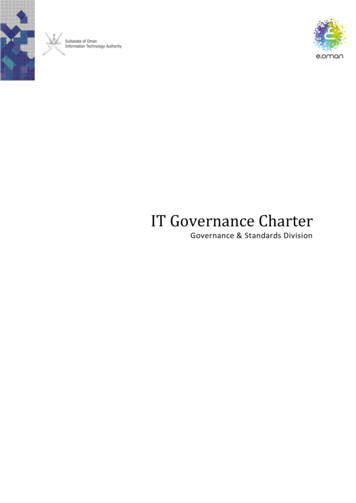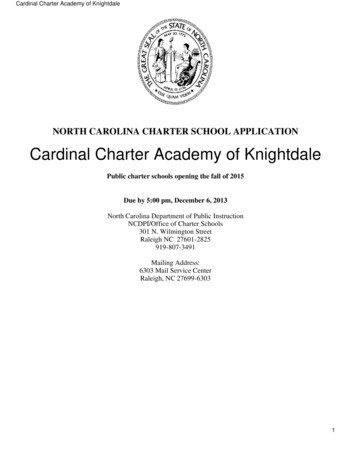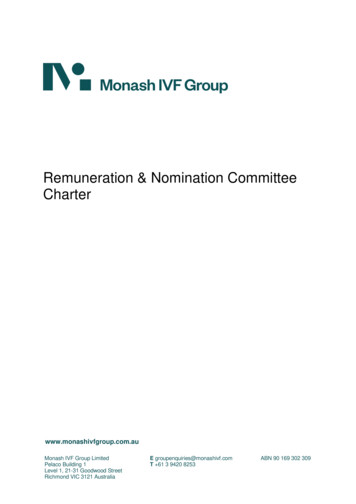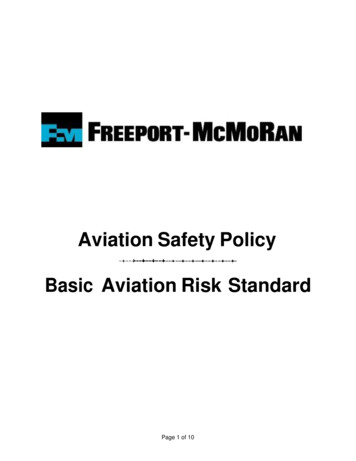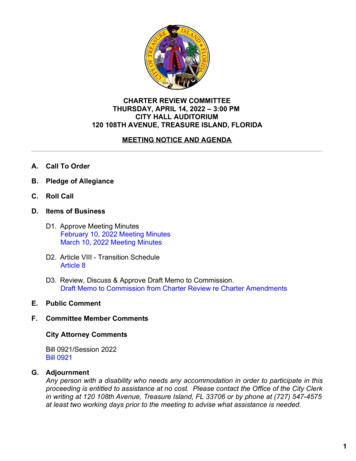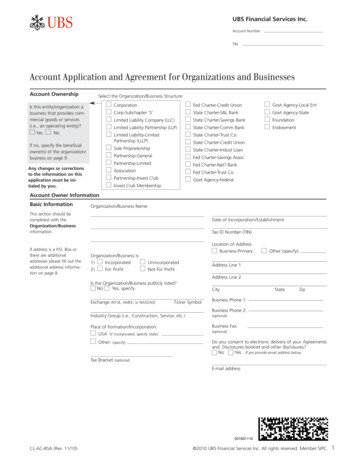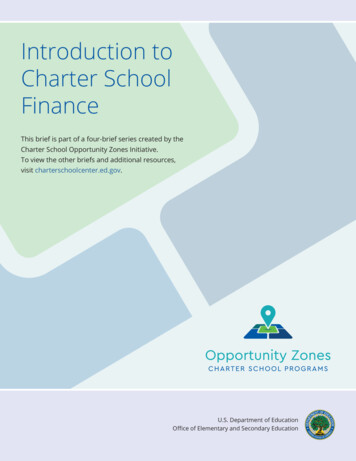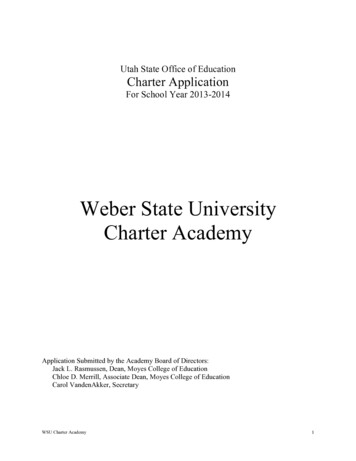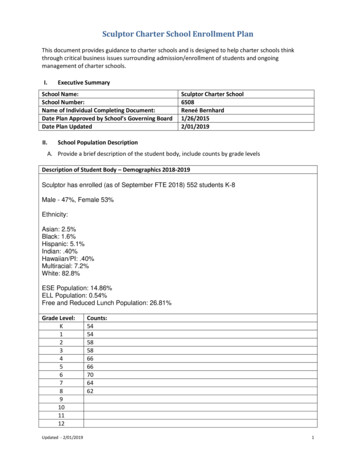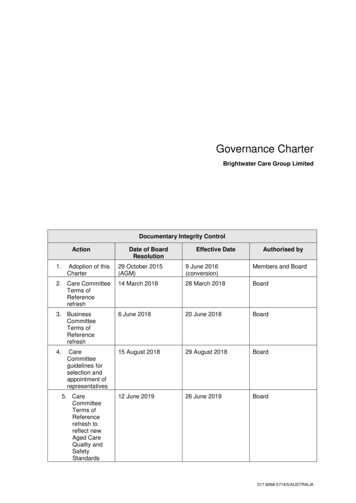
Transcription
Governance CharterBrightwater Care Group LimitedDocumentary Integrity ControlAction1.Adoption of thisCharterDate of BoardResolutionEffective DateAuthorised by29 October 2015(AGM)9 June 2016(conversion)Members and Board2. Care CommitteeTerms ofReferencerefresh14 March 201828 March 2018Board3. BusinessCommitteeTerms ofReferencerefresh6 June 201820 June 2018Board4.15 August 201829 August 2018Board12 June 201926 June 2019BoardCareCommitteeguidelines forselection andappointment ofrepresentatives5. CareCommitteeTerms ofReferencerefresh toreflect newAged CareQuality andSafetyStandards017-8068-5714/5/AUSTRALIA
6. Updating ofMission,Vision andValues inAppendix C14 August 201928 August 2019Board7. *8. *9. *(*)to be completed as the Charter may be amended or varied from time to time.017-8068-5714/5/AUSTRALIA
Table of Contents1Introduction22The Brightwater Philosophy33Board Charter33.1Role of the Board33.2Responsibilities of the Board and Management33.3Board Members53.4Board members and Executive Officers – Policy Requirements93.5Board Meetings93.6Board Committees113.7Key Office Bearers123.8Member Meetings153.9Communications with members and other stakeholders153.10Policies Generally153.11Financial Integrity163.12Governance Disclosure16Appendix A17Organisation’s Constitution and By-laws17Appendix B18Structure of Board, Committees and Key Office Bearers and Accountability Flows18Appendix C19The Brightwater Philosophy19Appendix D20Proforma guidelines of governance structure and procedural workings for Committees20Appendix E(1)23Governance Committee Charter23Appendix E(2)27Audit and Risk Committee Charter27Attachment 131Appendix E(3)34Care Committee Charter34Appendix E(4)40Business Committee Charter40Appendix F43Board Members’ and Executives’ Code of Conduct43Appendix G46Page (i)017-8068-5714/5/AUSTRALIA
Conflict of Interest Protocol46Appendix H53Organisation Code of Conduct/Values53Appendix I56Job Description – Chief Executive Officer – Delegated Authority56Appendix J59Risk Management Policy59Appendix K61Board Calendar (Strategic Governance Issues)61Appendix L63Contents of Directors’ Letter of Appointment63Appendix M64Board and Management Performance Enhancement Policy64Appendix N76Remuneration Policy76Appendix O78Diversity Policy78Appendix P84Communications with Members and other stakeholders84Page (ii)017-8068-5714/5/AUSTRALIA
Defined terms used in this CharterWhere used in this Charter the following terms have the following meaning ascribed to them:“ACNC” means the Australian Charities and Not-For-Profits Commission.“ACNC Act” means the Australian Charities and Not-for-profits Commission Act 2012 (Cth).“Appendix” means an appendix to this Charter;“ASIC” means the Australian Securities and Investments Commission;“Board” means the board or committee of management (howsoever described) of theOrganisation;“By-laws” means any by-laws adopted by the Board in the terms of the Constitution;“Charter” means this governance charter as adopted by the Board, as it may be varied from time totime by resolution of the Board;“CEO” means the chief executive officer (howsoever described) of the Organisation, or the personwithin the Organisation who effectively fulfils that function;“CFO” means the chief financial officer (howsoever described) of the Organisation, or the personwithin the Organisation who effectively fulfils that function;“Chair” means the chair of the Board;“Committee” means a committee of the Board;“Constitution” means the constitution of the Organisation;“Corporations Act” means the Corporations Act 2001 (Cth);“Director” means a director or Board member of the Organisation;“Ensure” and “Assure”, and derivations of those words, when used in relation to theresponsibilities or duties of a Director, the Chair, the Board, the CEO, CFO, Secretary or otherofficer of the Organisation, means to take all reasonable steps, take reasonable care and make allreasonable and appropriate enquiries within the person’s scope of authority and within theresources reasonably available to the person, so that the stated matter which is to be “ensured” or“assured” might reasonably be expected to be appropriately addressed, or done or not done, as thecontext requires;“Member” means a member of the Organisation, other than when used in Appendix F;“Organisation” means Brightwater Care Group Limited;“Secretary” means the corporate secretary (howsoever described) of the Organisation, or theperson within the Organisation who effectively fulfils that function; and“Section” means a section of this Charter.Page 1017-8068-5714/5/AUSTRALIA
1Introduction1.1This Charter is designed as an overarching statement of policy: to prescribe a range of governance principles and practices to apply to theOrganisation; pursuant to which discrete instruments relating to matters relevant to governancewithin the Organisation can be generated and incorporated as appendices to thisCharter; and to set forth certain protocols relating to the functions, responsibilities and behaviourof relevant personnel within the Organisation.1.2The Organisation is committed to implementing high standards of governance. Indetermining what those high standards should involve, amongst other relevant governanceguidelines and principles, the Organisation has had regard to standards generallyendorsed for like organisations by relevant governance and director institutes.1.3The Organisation is registered with ASIC as an Australian public company limited byguarantee and therefore abides by the Corporations Act (as applicable), and as a charitywith the ACNC and therefore abides by the ACNC Act.1.4The Charter takes into consideration the Constitution, Corporations Act, the ACNC Act, andthe ACNC Governance Standards.1.5This Charter is intended to complement the Constitution, however to the extent ofinconsistency between this Charter and the Constitution, the terms of the Constitutionprevail.1.6This Charter is intended to operate by way of a series of Sections and/or Appendices whichmay be added to or varied from time to time, the totality of which comprise this Charter.1.7A copy of this Charter is to be:(a)kept with the Organisation’s corporate secretarial records;(b)made available to each Director and senior executive for reference purposes; and(c)disclosed on the Organisation’s web-site under its “Governance” section.1.8Relevant Sections and Appendices to this Charter will be the subject of specificcommunication and education to relevant personnel within the Organisation to assist themin meeting the Organisation’s expectations of them.1.9The Organisation accepts that merely by the Board adopting this Charter, of itself does notensure the actual or cultural compliance within the Organisation of the principles andpolicies espoused by this Charter.1.10It is the Board’s commitment to work towards the principles and policies in this Charterbecoming a practical and cultural reality for the Organisation in all respects.1.11This Charter has been adopted by resolution of the Board on the date appearing on thecover to this Charter, effective from the date also there appearing. It can only be amendedor varied by resolution of the Board.Page 2017-8068-5714/5/AUSTRALIA
2The Brightwater Philosophy2.1The over-arching Brightwater Philosophy is set out in Appendix C of this Charter.2.2It is intended to form an ethical and cultural backdrop against which proposed actions anddecisions of the Organisation and its people may be better informed.3Board Charter3.1Role of the Board3.2(a)The Board is the guardian of the purpose for which the Organisation wasestablished, its philosophy and values. The Board is directly accountable to themembers for the pursuit of those aims and for the overall performance of theOrganisation.(b)This Board charter sets out the principles for the operation of the Board and todescribe the functions of the Board and those functions delegated to managementof the Organisation.Responsibilities of the Board and Management(a)Board ResponsibilityThe Board is responsible for the overall management and strategic direction of theOrganisation and for delivering accountable organisational performance inaccordance with the Organisation’s goals and objectives. In performing its role, thespecific responsibilities reserved to the Board include: providing strategic direction to the Organisation and deciding upon theOrganisation’s strategies and objectives in conjunction with the CEO; monitoring the strategic direction of the Organisation and the attainment ofits strategies and objectives in conjunction with the executive; monitoring the operational and financial position and performance of theOrganisation generally; driving performance and mission, organisational purpose and outcomes; assuring a prudential and ethical base to the Organisation’s conduct andactivities having regard to the relevant interests of its stakeholders; assuring the principal risks faced by the Organisation are identified andoverseeing that appropriate control and monitoring systems are in place tomanage the impact of these risks; reviewing and approving the Organisation’s internal compliance and controlsystems and codes of conduct; assuring that the Organisation’s financial and other reporting mechanismsare designed to result in adequate, accurate and timely information beingprovided to the Board; appointing and, where appropriate, removing the CEO, monitoring otherexecutive appointments, and planning for executive succession; overseeing and evaluating the performance of the CEO, and through theCEO, receiving reports on the performance of other executives in thePage 3017-8068-5714/5/AUSTRALIA
context of the Organisation’s strategies and objectives and theirattainment;(b) reviewing and approving the CEO's remuneration; reviewing and approving, in conjunction with the CEO, other executiveremuneration; appointing and where appropriate, removing the Secretary; approving the Organisation’s budgets and business plans and monitoringmajor capital expenditures, acquisitions and divestitures, and capitalmanagement generally; deciding on the responsible financial management of the Organisationincluding how money will be managed, such as how electronic transfers,negotiable instruments or cheques must be authorised and signed orotherwise approved; ensuring that the Organisation’s financial results are appropriately andaccurately reported on in a timely manner in accordance with regulatoryrequirements; as part of its oversight and monitoring function, overseeing that theOrganisation’s governance systems and processes are designed andapplied to assure compliance with all relevant laws, governmentalregulations and accounting standards; ensuring that the Organisation’s affairs are conducted with prudentialgovernance transparency and accountability; overseeing the design and implementation of appropriate and effectivepolicies, processes and codes of conduct for the Organisation (includingwith respect to ethics, values, conduct, employment, remuneration,diversity and otherwise) as well as monitoring and reviewing those policies,processes and codes of conduct from time to time; ensuring sound Board succession planning including strategies to assurethe Board is comprised of individuals who are well able to discharge theresponsibilities of Directors of the Organisation; providing appropriate Board induction and training for Directors; and overseeing member engagement, reporting and information flows.Management Responsibility - Authority Delegated to Senior ExecutiveManagement and Delegated Authority Matrix(i)The Board has delegated to the CEO (for sub-delegation as appropriate tohis/her senior executive and management team), authority over themanagement, operations and day to day affairs of the Organisation.(ii)This delegation of authority includes responsibility for: developing business plans, budgets and strategies forconsideration by the Board and, to the extent approved by theBoard, implementing these plans, budgets and strategies; managing the financial affairs including:(A)signing contracts;(B)initiating orders for payment;(C)receiving or depositing money;(D)signing cheques; andPage 4017-8068-5714/5/AUSTRALIA
(E)withdrawal of money from the Organisation’s accounts.All authorisations to expend funds or commit the Organisation tofuture payments in excess of 25,000 must be made by two (2)signatories and records maintained for audit on proof ofauthorisation. The CEO has the responsibility to establish andenforce written procedures for all financial delegations;3.3 ensuring the Organisation’s operations, and the actions of itsofficers, are within the parameters set by the Board from time totime and that the Board is kept informed of material developmentsin the Organisation’s affairs, operations and business; where proposed transactions, commitments or arrangementsexceed threshold parameters set by the Board, referring the matterto the Board for its consideration and approval; identifying and managing operational and strategic risks for theOrganisation and, where those risks could have a material impacton the Organisation, formulating strategies for managing andmitigating those risks, including for consideration and endorsement(as applicable) by the Board; managing the Organisation’s financial and other reportingmechanisms, and control and monitoring systems, to ensure thatthese mechanisms and systems capture all relevant materialinformation on a timely basis, are functioning effectively and arefounded on a sound basis of prudential risk management; ensuring that the Board is provided with sufficient accurateinformation on a timely basis in regard to the Organisation, itsoperations and affairs, and in particular with respect to theOrganisation’s performance, financial condition, operations andprospects, to reasonably inform and position the Board to fulfil itsgovernance responsibilities; and implementing the policies, processes and codes of conductapproved by the Board and facilitating the monitoring andreviewing of, and reporting against, those policies, processes andcodes of conduct.(iii)The scope of the CEO's role, authority and responsibilities is moreparticularly set out in Appendix “I” to this Charter.(iv)The scope of the CEO’s role, authority and responsibilities must also be setout in formal job descriptions in his/her employment contract (or letter ofappointment) with the Organisation.(v)The CEO will propose from time to time for consideration and adoption (asapplicable) by the Board, a Delegated Authority Matrix (or similarinstrument) specifying the levels of delegated authority applicable at Board,Director, CEO, CFO, Secretary, executive and other management levels(as appropriate).Board Members(a)Appointment(i)Members of the Board are appointed in the terms of the Organisation’sConstitution.Page 5017-8068-5714/5/AUSTRALIA
(ii)Although the election of Board members is substantially the province of theMembers in general meeting, within the scope of its Constitution theOrganisation commits to the following principles:(A)(B)The Board has an appropriate number of independent nonexecutive directors who: are the majority of the Board; can challenge and hold management to account; represent and act in the best interests of the Organisation; are accountable to the Organisation’s Members as awhole.The Board should comprise of a minimum of 6 Directors, and amaximum of 10 Directors, including a minimum of 4 memberelected Directors, such that it is: of sufficient size so that the requirements of itsresponsibilities can be met, and changes to thecomposition of the Board and its Committees can bemanaged, without undue disruption; and. not so large as to be unwieldy.(C)The Board comprises Directors with a blend of skills, experienceand attributes appropriate for the Organisation, its strategies andits operations.(D)The principal criterion for the appointment of new Directors is theirability to add value to the Organisation, its objectives and itsoperations.(E)The Board respects and values the benefit of diversity (includingskills, experience, perspective, gender, culture, age and otherwise)in order to enhance the probability of achievement of theOrganisation’s objectives.(F)All Board members respect the role of the Governance Committee(refer Appendix E(1)) with respect to Board succession planning.(iii)The Organisation should undertake appropriate checks (e.g. as tocharacter, experience, education, criminal and bankruptcy history), andwhether the person has been disqualified from managing a corporationunder the Corporations Act or being a responsible person under the ACNCAct before appointing a prospective Director or putting him/her forward forcandidacy for election or appointment.(iv)The Organisation should provide its Members with all “material information”in its possession relevant to a decision as to whether or not to elect or reelect a director. “Material information” may include but is not limited to: biographical details (including relevant qualifications, skills andexperience); any other material directorship currently held by the person; a statement by the Board if it does not support the election or reelection of the person;Page 6017-8068-5714/5/AUSTRALIA
a statement whether the Board considers the person qualifies as an“independent director”; for candidates standing for election for the first time: (v)(b)-any materially adverse information revealed by the checks under3.3(a)(iii) above;-any prospective conflict of interest or material circumstances thatmay influence or impact upon the person’s capacity to bringindependent judgement and act in the best interests of theOrganisation generally; andfor directors standing for re-election:-the term of office currently served by the director;-any other material information likely to be relevant to theMembers’ decision.The candidate for appointment/election/re-election as a Director shouldprovide the Governance Committee with: all requisite information referred to in (iv) above requested of thecandidate by the Board: a consent for the Organisation to conduct background checks referredto in (iii) above; a declaration confirming that they are not disqualified from managinga corporation under the Corporations Act or being a responsibleperson under the ACNC Act and that they understand what it meansto be disqualified; details of his/her other commitments that may impact upon thecandidate’s responsibilities as a Director; and an acknowledgement that he/she has sufficient time available tocommit to the Organisation and fulfil his/her responsibilities as aDirector.RemunerationAppendix N sets out the Organisation’s remuneration policy for Board members.(c)(d)Agreement by Board Members(i)Prior to, or upon their appointment, Board members are to be issued aformal letter of appointment (for signing and acceptance by them at thetime of their appointment) covering the key terms of their appointmentincluding those set out in Appendix L.(ii)By accepting appointment to office, the Board member agrees to complywith the Constitution and this Charter including its Appendices.Access and Indemnity Deed and D&O Insurance(i)The Organisation will execute with each Board member and Secretary adeed of access and indemnity in such reasonable form approved from timeto time by the Board.(ii)The Organisation will arrange for the benefit of each Board member,subject to cover availability at commercially acceptable premiums to thereasonable satisfaction of the Board, a policy of directors’ and officers’insurance in such reasonable form approved by the Board.Page 7017-8068-5714/5/AUSTRALIA
(e)(f)Board Member “Independence”(i)An independent Board member operates independently of executivemanagement and free of any business or other relationship (personal,business or otherwise) that could materially interfere with, or couldreasonably be perceived to materially interfere with, the exercise of theirunfettered and independent judgment.(ii)Independent Board members accordingly assist in ensuring that the Boardand the Organisation operate in the best interests of the Organisationhaving regard to the goals and objectives of the Organisation.(iii)The assessment of whether a Board member is independent is a matter ofjudgement for the Board as a whole and includes concepts of:(A)length of time served as a director and whether the person hasbeen a director of the Organisation for such a period that his or herindependence may have been compromised; and(B)materiality.(iv)All Board members are required to disclose to the Board and theGovernance Committee (via the Secretary) any interest, position,association, relationship or information (and any changes thereof) whichmay be relevant or material to that assessment.(v)The Chair, and at least a majority of Directors, should be independent,unless special circumstances exist, are disclosed and are approved of bythe Board as an exception to this requirement.(vi)The Organisation will disclose on its website: the names of its Board members considered by the Board to be“independent”; the length of service of each Board member; if the Board determines that a Board member’s previously assessedand disclosed “independence” has changed.Independent Professional AdviceA Board member is entitled to seek independent professional advice (including butnot limited to legal, accounting and financial advice) at the Organisation’s expenseon any matter connected with the discharge of his or her responsibilities, inaccordance with the procedures and subject to the conditions set out below:(i)the Board member must seek the prior approval of the Chair (or DeputyChair as appropriate having regard to the relevant circumstances);(ii)in seeking such prior approval, the Board member must provide details of: the nature of and reasons for the independent professional advice tobe sought; the likely cost of obtaining the independent professional advice; details of the independent adviser the Board member proposes toinstruct;(iii)the approval of the Chair (or Deputy Chair as appropriate) must not beunreasonably withheld; and(iv)the Chair (or Deputy Chair as appropriate) may prescribe a reasonablelimit on the amount that the Organisation will contribute towards the cost ofobtaining such advice.Page 8017-8068-5714/5/AUSTRALIA
3.4Board members and Executive Officers – Policy Requirements(a)(b)Generally – Codes of Conduct and Policies(i)The Organisation has adopted, and Board members and executive officers(as applicable) shall comply with and abide by the Board Members’ andExecutives’ Code of Conduct set out in Appendix F to this Charter whichoutlines duties imposed on Board members and executive officers underthe Corporations Act and the ACNC Act. This code of conduct is inaddition to and in augmentation of the Organisation’s Code ofConduct/Values set out in Appendix H.(ii)Board members and executive officers shall also abide by such otherpolicies, codes and protocols as may be adopted from time to time by theOrganisation and are expected to take a leadership role in their complianceand enforcement.(iii)These Codes of Conduct in Appendices F and H are to be read in thecontext of the “Brightwater Philosophy” in Section 2 of this Charter.Performance Enhancement and Evaluation(i)(ii)3.5Enhancement:(A)The Organisation commits to providing induction programs for newBoard members and executives as well as providing opportunitiesfor the continuing professional development of existing Boardmembers and executives to equip them to better serve theOrganisation.(B)Appendix M sets forth the Organisation’s Board and ManagementPerformance Enhancement Policy.Evaluation and Review(A)The performance of the Board (as a whole), each BoardCommittee, Board members (individually) and each executive willbe periodically reviewed, desirably annually or thereabouts and atother times as decided upon by the Board (and/or the CEO in thecase of executives), against measurable and qualitativebenchmarks as may reasonably be determined from time to timeby the Board (and/or the CEO in the case of executives) havingregard to generally accepted governance standards.(B)This task is delegated by the Board to the Governance Committee.Appendix M (Attachment 2) sets forth the Organisation’s Boardevaluation policy.(C)Appendix M (Attachment 3) sets forth the Organisation’s SeniorExecutive evaluation policy.Board Meetings(a)(b)Procedures(i)As far as possible, agendas and supporting papers shall be despatched areasonable period in advance of the meeting.(ii)Subject to the Corporations Act, a quorum for a Board meeting is thegreater of 2 Board members and not less than 50% of the Board.Frequency(i)The Directors may meet, adjourn and otherwise regulate their Boardmeetings as they think fit.Page 9017-8068-5714/5/AUSTRALIA
(c)(ii)Subject to the Constitution, the Board should meet at least 6 times perannum, and as often as is necessary to effectively and efficiently fulfil itsfunctions and discharge its responsibilities.(iii)The Board should also schedule annual (or thereabouts) dedicatedstrategy development and/or review meetings.(iv)Directors are expected to attend at least 75% of all Board meetings in anyyear.VotingAlthough the preferred method of decision making is by consensus resolve, andsubject to any overriding provision in the Constitution, in relation to Boarddecisions:(d)(e)(f)(g)(i)each member of the Board including the Chair shall have one vote.(ii)in the case of an equality of voting, the Chair shall have a casting vote inaddition to his/her deliberative vote (except where there are only 2Directors entitled to vote on the resolution before the meeting).Minutes(i)Draft minutes of each Board meeting shall be recorded, initially settled bythe meeting chair and distributed to each member of the Board in a promptand timely manner after each Board meeting.(ii)The minutes of each Board meeting shall be submitted to the nextsucceeding meeting of the Board for their formal approval by the Boardand their signing by the meeting chair as a fair and correct record ofproceedings.(iii)The minutes shall be entered into the Organisation’s corporate secretarialrecords within such time periods as may be prescribed by statute orregulation and in any event within one month of the meeting.Venue and Time(i)Meetings should be held at such place and time as is reasonablyconsidered appropriate by the Chair to meet the needs of the Organisation.(ii)Subject to (i), the Chair will endeavour to meet the reasonable convenienceof the members of the Board (including having regard to each member’sother commitments, be they business, domestic, personal or otherwise) insetting the meeting times and venues.(iii)A meeting of the Board may be held using any technology consented to byall Directors.Generally(i)Meetings of the Board shall be conducted in compliance with theConstitution and any legislative or regulatory requirement binding upon theOrganisation and otherwise in accordance with generally acceptedprocedures for board meetings of like organisations.(ii)Subject to (i) and the other provisions of this Charter, the Chair shalldetermine the manner and process by which Board meetings shall be held.(iii)The Board should consider meeting periodically in “closed session” withoutexecutive Directors and executives present.Board Calendar(i)To assist the Board in ensuring timely discharge of its duties each year, theBoard may from time to time adopt a planning calendar which should atPage 10017-8068-5714/5/AUSTRALIA
least include on it each year reports on strategic governance issues of thegeneral nature set forth in Appendix K.(ii)3.6The planning calendar shall be developed by the Secretary in consultationwith the Chair and the CEO with an aim for it to be tabled and adopted bythe first Board meeting of each financial year.Board Committees(a)Overall Board, Committee and key office bearer structureThe Board, Committee and key officer bearer structure for the Organisation is setout in Appendix B to this Charter.(b)Committee structure(i)(c)The Board has established the following standing Committees to assist theBoard in the performance of its responsibilities: Governance Committee; Audit and Risk Committee; Care Committee; and Business Committee.(ii)Other Committees may from time to time be established by the Board todeal with discrete functions or matters of special importance to theOrganisation.(iii)For efficiency of operations, where 2 Board Committees comprise thesame members, such Committees may sit contemporaneously with oneanother discharging the functions and responsibilities of each Committee inparallel with one another, although in such cases discrete minutes for eachCommittee’s deliberations within the scope of its terms of reference shouldbe prepared.Committee terms of reference(i)Each Committee has an approved charter and terms of reference underwhich authority is delegated by the Board. The charters and terms ofreference for each standing Committee can be found in Appendices E(1),E(2), E(3) and E(4) to this Charter.(ii)A proforma guidelines for the governance structure and proceduralworkings of each Committee (subject to the specific terms of reference andcharter for each Committee) appears as Appendix D.(iii)Generally, Committees have an advisory, reporting and recommendingfunction only to the Board. The Board remains responsible for the exerciseof power by the Committees, unless the Board has delegated deliberativeand/or executive power to the Committee and the Board believes onreasonable grounds in good faith and after making proper enquiry: that the Committee would exercise the power in conformity with theduties imposed on the Board by legislation and the Constitution;and that the Committee is reliable and its members competent inrelation to the power delegated.Page 11017-8068-5714/5/AUSTRALIA
(d)3.7Committee membership and operations(i)Committees
the ACNC Governance Standards. 1.5 This Charter is intended to complement the Constitution, however to the extent of inconsistency between this Charter and the Constitution, the terms of the Constitution prevail. 1.6 This Charter is intended to operate by way of a series of Sections and/or Appendices which
